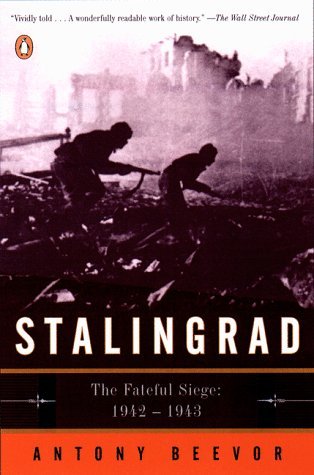More on this book
Community
Kindle Notes & Highlights
In the whole Stalingrad campaign, the Red Army had suffered 1.1 million casualties, of which 485,751 had been fatal.
officer’s shoulder boards, which had just been reintroduced by Stalin,
The press must always employ the word Bolshevik, not Russian.
In his diary on 17 December he wrote: ‘In future, cards to relatives should no longer be delivered, because they offer an access door to Germany for Bolshevik propaganda.’
This time, however, the scapegoats for defeat would not be Communists and Jews as in 1918, but the general staff and the aristocracy, still closely associated in the popular mind.
Hitler, who passionately believed that it was the duty of womankind to be decorative, objected to this, and Goebbels was forced to announce that ‘there is no need for a woman to make herself ugly’.
‘Enjoy the war, the peace will be much worse.’
The invasion of the Soviet Union had forced the Russians to defend Stalinism. Now the threat of defeat forced Germans to defend Hitler’s regime and its ghastly failure.
‘You cannot stop an army which has done Stalingrad.’
Almost any building work in the city uncovered human remains from the battle.
They found that at least 9,796 civilians had lived through the fighting, surviving in the battlefield ruins. They included 994 children, of whom only nine were reunited with their parents.
Death promised a release from suffering, and towards the end, drained of pain as well as strength, there was no more than a sense of floating weightless.
Although surrounded by snow, they suffered the fate of the Ancient Mariner, knowing the dangers of consuming it.
Anger at the conditions led to prisoners scraping handfuls of lice off their own bodies and throwing them at their guards. Such protests provoked summary execution.
The first to die were generally those who had been large and powerfully built. The small thin man always stood the best chance.
Chances of survival proved brutally dependent on rank. Over 95 per cent of soldiers and NCOs died, 55 per cent of junior officers and just 5 per cent of senior officers.
Molotov later confirmed their fears, with his declaration that no German prisoners would see their homes until Stalingrad had been rebuilt.
Meanwhile, the Soviet victory at Stalingrad had been the greatest boost imaginable to Communist propaganda throughout the world. It was an inspiration even to those who had lost their faith after the Stalinist inquisition in the Spanish Civil War or the Nazi-Soviet Pact of 1939. The story roused left-wing sculptors, painters, novelists and poets, such as Pablo Neruda, who in his Nuevo Canto de Amor a Stalingrado wrote a poem of international love to a city whose name had brought hope to the world.
‘Doctor, the miracle of the twentieth century: a Jew as one of Adolf Hitler’s soldiers.’
The inventiveness of prisoner-of-war doctors produced brilliant improvisations.


